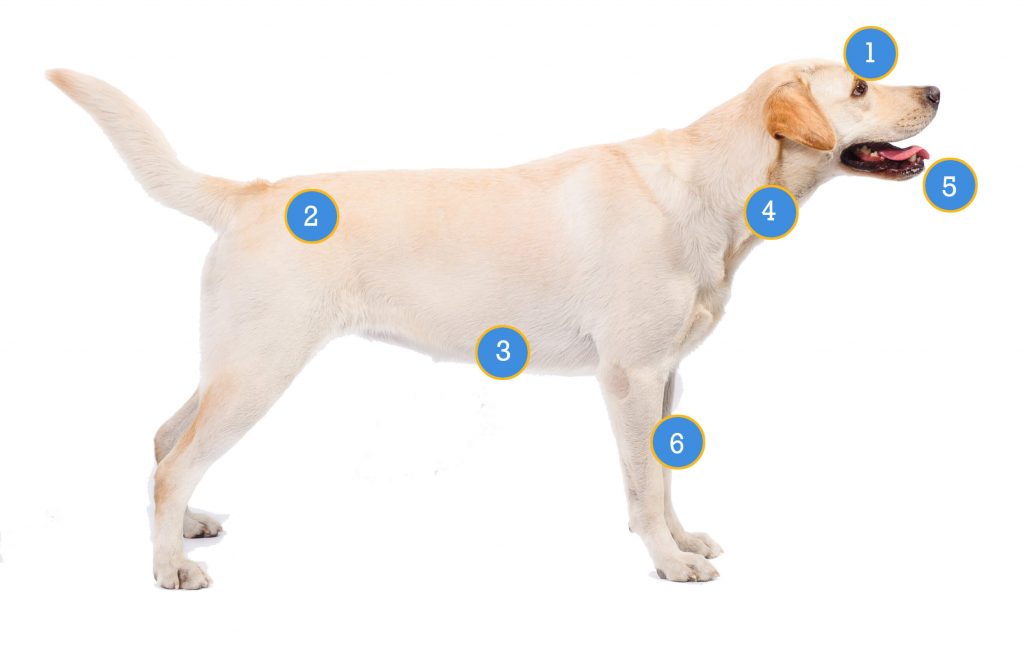Time to read: 7 mins
Guide to Labrador Retrievers
Key stats
Life expectancy: 10-14 years
Height: 22 inches
Weight: 65 pounds
About Labradors
Labradors are one of the most popular dog breeds in the UK. They have gained their good reputation largely due to their playful and loving nature alongside possessing canny intelligence. In fact, they are one of smartest dog breeds in the world.
The breed has four distinct colours: golden yellow being the most common, brown, black and even silver, which is growing more in popularity. They are definitely not lapdogs, although that won’t stop them from trying to be! Labradors can be considered the perfect family pet as their affectionate temperament makes them trusted to be around young children. Although it is important to remember, every dog has its own personality.
Labrador’s legacy
Labradors originate from Canada. They were first used on fishing boats to help collect fish during their expeditions. Their thick, waterproof coats are perfect for keeping them warm in the freezing waters of Canada. While some dogs despise water, swimming is very easy for a Labrador. This is mostly due to their long tails and large webbed paws which help them to float and turn.
In the early 1800s Labradors were bought to the UK. Here they were used as hunting dogs, predominantly as duck retrievers. This is where the “retriever” in their name comes from. Their good manners and high energy made them the perfect partner and they quickly grew in popularity.
Factors to consider when owning a Labrador
Exercise
Labradors are a large dog breed that need space to run and play in order to release their energy. They can only entertain themselves so much and without daily exercise they can have pent up energy which can lead to frustration and destructive behaviour. Fully grown Labradors need about two hours of exercise a day. Puppies, on the other hand, require a lot less exercise. It is good to start them off with 15 minutes and build up the time as they get older. This not only helps to keep them physically fit but it keeps them mentally active.
Labradors are very sociable and do not do well when left alone for extended periods of time. Within your family dynamic it is important to consider if someone will be at home during the day to keep your Lab company. They can get anxious if left alone for too long. Some Labs are more needy than others, so you will have to get to know yours to see how much attention they require on a day to day basis.
Puppy training
Whilst they are not difficult dogs to train it is important you begin while they are puppies to cement good behaviour and manage any bad habits. Since Labs have so much energy and are born socialites, they are going to do extremely well in puppy training classes and if possible, they will love you more for it too!
Cost
The popularity of the colour at the time plays a large part in the price you will pay for your Labrador. You can expect to spend up to £850 when purchasing a Labrador puppy from a breeder. This price increases drastically if you are purchasing a puppy that comes from an award winning bloodline. These puppies can be anywhere up to £3,000.
Having a puppy join your household is a costly task. There are many factors that need to be taken into consideration. Some of these include:
- Microchipping
- Vaccinations
- Neutering
- Flea treatments
- Leash and collar
- Food, treats and bowls
- Toys
- Beds
Owning a large dog like a Labrador can cost anywhere up to £1,600 in the first year alone. These are expected costs, there could be unexpected ones too.
Grooming
Labs are known for their thick coats which tend to shed. This is inevitable. To help with the shedding they’re going to need the occasional bath and shampoo. Don’t forget to brush their coats in order to keep those luscious locks in pristine condition.
Labrador health concerns
All dogs get sick and require medical attention at some point, Labs are no exception. In order to keep on top of your dog’s condition, check-ups should be conducted by your vet.

Some conditions to be aware of:
- Progressive Retinal Atrophy (PRA): is a collection of diseases that degenerate the lining at the back of the eye-retina. The retina absorbs and reflects light. PRA leads to a failure of the retina and results in blindness. Dogs can be DNA tested prior to breeding.
- Hip dysplasia: Poor hip joint development resulting in pain and swelling leading to early onset arthritis. Careful weight and exercise management can often help although surgery might be necessary in some cases. It is important to ensure the parents are hip scored prior to breeding.
- Obesity: You can regulate this by limiting the amount your Labrador is fed to a healthy standard and ensuring they get the recommended amount of daily exercise.
- Hypothyroidism: Reduced production and release of T3 and T4 hormones by the thyroid gland. More commonly diagnosed in middle to older dog aged 4-10 years. Symptoms and blood tests will confirm the conditions. This condition requires medication to replace the hormones.
- Collapse from exhaustion: Since Labs are so active and love to play they do not stop when fatigued. This could result in them collapsing. If your Lab has this condition it does not mean that they cannot exercise but you should limit the amount and length of intense exercise. This condition can be exacerbated by high temperatures so it is important to ensure your Labrador is hydrated.
- Elbow dysplasia: One or both elbows develop abnormally often hereditary and can be managed with weight and exercise management although some require surgery.
If you would like any more information on your Labrador or conditions it may have then please contact one of our Registered Veterinary Nurses on the Scratch & Patch Careline.
Food
When it comes to your Labradors growth, the food it eats are of the utmost importance. Labradors need food that is suited for large dog breeds. This is to keep them healthy by giving them all the desired nutrients. Having a healthy diet from an early age can keep diseases like hip dysplasia at bay as it allows the hips to form correctly. There are many options on the market and it can be overwhelming at first. Buying your Labrador’s food will require research to know what the best food for your dog is.
Insurance
When buying a Labrador it is important they are screened as a puppy. This can be done by your vet or breeder. This helps ensure your puppy has no underlying conditions you should be aware of.
It is important to have pet insurance so that you don’t have to worry about your finances when you should be worrying about your pet’s health. When it comes to insurance, it is better to insure your Labrador as a puppy. Younger animals are cheaper to ensure as they are less likely to require treatment and have no claims made for them. Often conditions do not show up until later in life. Having your Labrador insured from a young age will mean the problems your dog may get will be covered through your insurance provider. While genetics can give you an idea of what conditions your dog may have, they could also have conditions that could not be foreseen.






